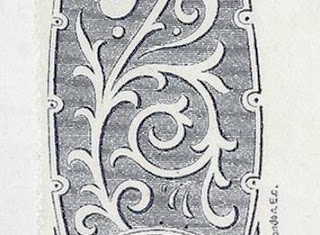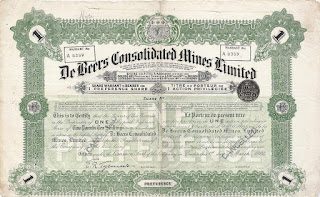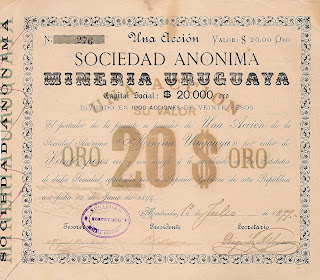In auction catalogues that are written in English, you probably have noticed lot descriptions containing a phrase like 'scrollwork at left'. Such an expression will refer to a whole of ornamental design elements at the left side of a share or bond certificate. The term is an English term and you will often find such design elements on English shares and bonds. An example of scrollwork is printed at the left on the share shown below, hence the expression 'scrollwork at left'. Is there also something like 'scrollwork at right'? Ofcourse, scrollwork can be seen on all possible positions on a certificate.
The Para Electric Railways and Lighting Company, Limited
Certificate for 5% first debenture stock, 1968
Printed by W.H. Rickinson & Son
left image: detail of the 'scrollwork at left'
double-click to enlarge images
double-click to enlarge images
Origins of the term 'scrollwork'
Scrollwork is an ornamental design element resembling a spiral. The name is derived from the word scroll which is a roll of paper, parchment or papyrus. The edge view of a scroll forms a spiral.
 |
| The term scrollwork is derived from the word scroll, which is a roll of paper. The edge view of the paper forms a spiral. detail from the certificate below |
 |
| Nouvelle Compagnie de la Ligne Internationale d'Italie par le Simplon (Chemins de Fer et Navigation) Bond for 525 Francs, 1868 double-click to enlarge image |
In general, descriptions in English catalogues refer to 'scrollwork' as the whole of a larger design element consisting of spirals and other ornamental elements such as engine turned spirographs. You can see a nice example of scrollwork on the certificate of the Para Electric Railways and Lighting Company, shown in the first section of this article. The spirals, the scrolls, can be found all over the ornamental element. I've marked some of these with a red circle on the detail image below. The larger geometric pattern in the middle of the image is not a scroll, but an engine turned element.
 |
| scrollwork detail from the certificate of the Para Electric Railways and Lighting Company (see also above) |
Scrollwork and foliage
Often the scrollwork may consist of a regular pattern of circles and spirals decorated with foliage forms. A good example can be found on the earlier shown share of the Ligne Internationale d'Italie par le Simplon. The rear side of the share shows the presence of such foliage forms all around the border.
 |
| Pattern of scrolls decorated with foliage. Did you notice the lion's head ? Wonderful design work. Detail from the image below. |
Scrollwork and cartouches
Scrollwork is often used in combination with a cartouche. A cartouche is basically an ornamental frame, in the form of an oval or circular figure. Cartouches, enclosing a royal name, were already used by the ancient Egyptians. In the later Renaissance we see map-makers using cartouches with the coat of arms of countries. In scripophily, cartouches may contain a company name, company initials, a monogram, a map, a coat of arms, a denomination of the certificate, a bust and even an ostrich as you can see here.
 |
| Cartouche containing 'SIMPLON' Scrolls are located below the letters 'S' and 'N' and above the 'M' and 'L'. detail from the front side of certificate above |
Engraving scrollwork
Scrollwork as an element of ornate design has been used in many decorative applications such as architecture, furniture, metalwork, porcelain, musical instrument building, engraving and printing. Engravers of banknotes and securities were specialized in branches of engraving: lettering, portraits, vignettes, and scrollwork. Usually, an engraver did not excel in more than one of these branches. This situation contributed to an additional assurance against counterfeiting, as no single person could finish an engraving completely on his own.
Some conditions must be met in order to create a good looking scrollwork:
More examples of scrollwork in scripophily
You can enlarge the details by double-clicking the images.
Scrollwork as an element of ornate design has been used in many decorative applications such as architecture, furniture, metalwork, porcelain, musical instrument building, engraving and printing. Engravers of banknotes and securities were specialized in branches of engraving: lettering, portraits, vignettes, and scrollwork. Usually, an engraver did not excel in more than one of these branches. This situation contributed to an additional assurance against counterfeiting, as no single person could finish an engraving completely on his own.
 |
| detail from the 'scrollwork at left' The Nine Reefs Company, Limited (see full certificate below) |
Some conditions must be met in order to create a good looking scrollwork:
- the art of applying the right ratio's, e.g. the golden ratio, between scroll backbone lines
- the harmony between the rhythm of interior sections, namely shadings and supporting lines, with the exterior areas
- finding a balance between additional elements like leaves and tendrils and the overall design.
More examples of scrollwork in scripophily
You can enlarge the details by double-clicking the images.
De Beers Consolidated Mines Limited
 |
| Another cartouche with scrollwork. A great place for a denomination number to linger. |
 |
| A smaller scrollwork separates the English and the French denomination specification. |
 |
| De Beers Consolidated Mines Limited Diamond mining in South Africa 1 preference share of 2 Pounds 10 Shillings, 1902 |
Sociedad Anonima Mineria Uruguya
 |
| Detail from the upper border. Mineria Uruguaya |
 |
| Sociedad Anonima Mineria Uruguaya gold mining in Uruguay share of 20 Pesos Oro, Montevideo, 1899 |
Empress Oil and Uranium Corporation
 |
| A modern American example of scrollwork on a cartouche with a buste. |
 |
| Empress Oil and Uranium Corporation incorporated in Utah certificate for non assessable shares of 1 cent, 1956 |
The Nine Reefs Company, Limited
 |
| Detail from the delicate scrollwork embellishing the name of the company. |
F.L.
P.S. :By the way, 'scrollwork' is an English name. What is the corresponding word in your language ?
Reference





In German, the nearest term to 'scrollwork' is 'Rankenverzierung'. Thanks to Mr. V. Gutowski, http://www.gutowski.de , for this clarification.
ReplyDeleteF.L.